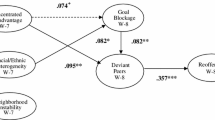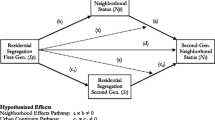Abstract
This study assesses the role of social context in explaining racial and ethnic disparities in arrest, with a focus on how distinct neighborhood contexts in which different racial and ethnic groups reside explain variations in criminal outcomes. To do so, I utilize a multilevel, longitudinal research design, combining individual-level data with contextual data from the Project on Human Development in Chicago Neighborhoods (PHDCN). Findings reveal that black youths face multiple layers of disadvantage relative to other racial and ethnic groups, and these layers work to create differences in arrest. At the family level, results show that disadvantages in the form of unstable family structures explain much of the disparities in arrest across race and ethnicity. At the neighborhood level, black youths tend to reside in areas with both significantly higher levels of concentrated poverty than other youths as well as lower levels of collective efficacy than white youths. Variations in neighborhood tolerance of deviance across groups explain little of the arrest disparities, yet tolerance of deviance does influence the frequency with which a crime ultimately ends in an arrest. Even after accounting for relevant demographic, family, and neighborhood-level predictors, substantial residual arrest differences remain between black youths and youths of other racial and ethnic groups.
Similar content being viewed by others
References
Anderson, E. 1999. Code of the Street. New York: W.W. Norton & Company.
Blinder, A. 1973. “Wage Discrimination: Reduced-Form and Structural Variables.” Journal of Human Resources 8:436–55.
Blumstein, A. 1982. “On the Racial Disproportionality of United States’ Prison Populations.” Journal of Criminal Law and Criminology 73:1259–81.
Burton, L. and R. Jarrett. 2000. “In the Mix, Yet on the Margins: The Place of Families in Urban Neighborhood and Child Development Research.” Journal of Marriage and Family 62:1114–35.
Chambliss, W. and R. Nagasawa. 1969. “On the Validity of Official Statistics: A Comparative Study of White, Black, and Japanese High-School Boys.” Journal of Research in Crime and Delinquency 6:71–77.
Cook, T.D., S.C. Shagle, and S.M. Degirmencioglu. 1997. “Capturing Social Process for Testing Mediational Models of Neighborhood Effects.” Pp. 94–119 in Neighborhood Poverty, Vol. II, edited by J. Brooks-Gunn, G.J. Duncan, and J.L. Aber. New York: Russell Sage.
Duncan, G.J. and J. Brooks-Gunn. 1997. Consequences of Growing Up Poor. New York: Russell Sage.
Duncan, G.J., J. Brooks-Gunn, and P.K. Klebanov. 1994. “Economic Deprivation and Early-Childhood Development.” Child Development 65:296–318.
Duncan, G.J. and S.W. Raudenbush. 2001. “Neighborhoods and Adolescent Development: How Can We Determine the Links?” Pp. 10–36 in Does It Take A Village? Community Effects on Children, Adolescents, and Families, edited by A. Booth and N. Crouter. Mahwah, NJ: Lawrence Erlbaum Associates.
Hindelang, M.J. 1978. “Race and Involvement in Common Law Personal Crimes.” American Sociological Review 43:93–109.
Jones, F.L. and J. Kelley. 1984. “Decomposing Differences Between Groups: A Cautionary Note on Measuring Discrimination.” Sociological Methods and Research 12:323–43.
Kirk, D.S. 2006. “Examining the Divergence Across Self-Report and Official Data Sources on Inferences About the Adolescent Life-Course of Crime.” Journal of Quantitative Criminology 22:107–29.
Loeber, R. and M. Stouthamer-Loeber. 1986. “Family Factors as Correlates and Predictors of Juvenile Conduct Problems and Delinquency.” Pp. 29–149 in Crime and Justice, Vol. 7, edited by M. Tonry and N. Morris. Chicago: University of Chicago Press.
Matsueda, R.L., K. Drakulich, and C.E. Kubrin. 2006. “Race and Neighborhood Codes of Violence.” Pp. 334–56 in The Many Colors of Crime: Inequalities of Race, Ethnicity and Crime in America, edited by R.D. Peterson, L.J. Krivo, and J. Hagan. New York: New York University Press.
McLeod, J.D., C. Kruttschnitt, and M. Dornfeld. 1994. “Does Parenting Explain the Effects of Structural Conditions on Children’s Antisocial Behavior? A Comparison of Blacks and Whites.” Social Forces 73:575–604.
McNulty, T.L. and P.E. Bellair. 2003. “Explaining Racial and Ethnic Differences in Serious Adolescent Violent Behavior.” Criminology 41:709–46.
Moos, R.H. and B.S. Moos. 1986. Family Environment Scale Manual. 2nd ed. Palo Alto, CA: Consulting Psychologists Press.
Oaxaca, R. 1973. “Male-Female Wage Differences in Urban Labor Markets.” International Economic Review 14:693–709.
Osgood, D.W., B.J. McMorris, and M.T. Potenza. 2002. “Analyzing Multiple-Item Measures of Crime and Deviance I: Item Response Theory Scaling.” Journal of Quantitative Criminology 18:267–96.
Peterson, R.D. and L.J. Krivo. 2005. “Macrostructural Analysis of Race, Ethnicity, and Violent Crime: Recent Lessons and New Directions for Research.” Annual Review of Sociology 31:311–56.
Rabe-Hesketh, S., A. Skrondal, and A. Pickles. 2004. “GLLAMM Manual.” Working Paper 160. University of California-Berkeley, Division of Biostatistics Working Paper Series.
Raudenbush, S.W. and A.S. Bryk. 2002. Hierarchical Linear Models: Applications and Data Analysis Methods. 2nd ed. Thousand Oaks, CA: Sage Publications.
Sampson, R.J. 1987. “Urban Black Violence: The Effect of Male Joblessness and Family Disruption.” American Journal of Sociology 93:348–82.
Sampson, R.J. and D.J. Bartusch. 1998. “Legal Cynicism and (Subcultural?) Tolerance of Deviance: The Neighborhood Context of Racial Differences.” Law and Society Review 32:777–804.
Sampson, R.J. and J.H. Laub. 1993. Crime in the Making: Pathways and Turning Points Through Life. Cambridge, MA: Harvard University Press.
Sampson, R.J., J.D. Morenoff, and S.W. Raudenbush. 2005. “Social Anatomy of Racial and Ethnic Disparities in Violence.” American Journal of Public Health 95:224–32.
Sampson, R.J., S.W. Raudenbush, and F. Earls. 1997. “Neighborhoods and Violent Crime: A Multilevel Study of Collective Efficacy.” Science 227:918–24.
Sampson, R.J. and W.J. Wilson. 1995. “Toward a Theory of Race, Crime, and Urban Inequality.” Pp. 37–56 in Crime and Inequality, edited by J. Hagan and R.D. Peterson. Stanford, CA: Stanford University Press.
Shaw, C. and H. McKay. 1942. Juvenile Delinquency and Urban Areas. Chicago: University of Chicago Press.
Wells, L.E. and J.H. Rankin. 1991. “Families and Delinquency: A Meta-Analysis of the Impact of Broken Homes.” Social Problems 38:71–93.
Yun, M.-S. 2004. “Decomposing Differences in the First Moment.” Economics Letters 82:275–80.
Author information
Authors and Affiliations
Additional information
This research was supported in part by Grant 2004- IJCX-0012 from the National Institute of Justice, by National Science Foundation Grant SES-021551 to the National Consortium on Violence Research (NCOVR), and by the Henry A. Murray Dissertation Award from the Radcliffe Institute for Advanced Study at Harvard University. The Project on Human Development in Chicago Neighborhoods was conducted with support of the John D. and Catherine T. MacArthur Foundation, the National Institute of Justice, and the National Institute of Mental Health. A previous version of this manuscript was presented at the 2005 annual meeting of the Population Association of America in Philadelphia. I thank Robert Goerge and John Dilts for their assistance in obtaining and processing the official arrest data used in this study. I also thank Andrew Abbott, Patrick Heuveline, John Laub, Andrew Papachristos, Rob Sampson, the editors, and the anonymous reviewers for helpful advice and comments on earlier versions of this manuscript. Any findings or conclusions expressed are solely those of the author.
Rights and permissions
About this article
Cite this article
Kirk, D.S. The neighborhood context of racial and ethnic disparities in arrest. Demography 45, 55–77 (2008). https://doi.org/10.1353/dem.2008.0011
Issue Date:
DOI: https://doi.org/10.1353/dem.2008.0011




